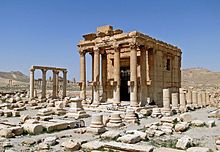Baalshamin
History
This name was originally a title of Baal Hadad, in the second millennium BC, but came to designate a distinct god circa 1000 BC.[5] The earliest known mention of this god or title is in a treaty of the 14th century BC between Suppiluliumas I, King of the Hittites and Niqmaddu II, King of Ugarit. One might take this to be a reference to Baal Hadad, and again when the name appears in a Phoenician inscription by King Yeḥimilk of Byblos—but other texts make a distinction between the two.In the treaty of 677 BC between King Esarhaddon of Assyria and King Ba‘al I of Tyre a curse is laid against King Baal if he breaks the treaty, reading in part:
May Baal-sameme, Baal-malage, and Baal-saphon raise an evil wind against your ships, to undo their moorings, tear out their mooring pole, may a strong wave sink them in the sea, a violent tide [. . .] against you.The god Baal-malage is otherwise unexplained, Baal-saphon here and elsewhere seems to be Ba‘al Hadad, whose home is on Mount Ṣaphon in the Ugaritic texts. But interpreters disagree as to whether these are here three separate gods or three aspects of the same god, a god who causes stormy weather on the sea.
In any case inscriptions show that the cult of Ba'al Šamem continued in Tyre from Esarhaddon's day until towards the end of the first millennium BC.
In Sanchuniathon's main mythology the god he calls in Greek 'Uranus'/'Sky' has been thought by some to stand for Ba'al Šamem. Sky is here the actual father of Baal Hadad (though Baal Hadad is born after his mother's marriage to Dagon). As in Greek mythology and Hittite mythology, Sky is castrated by his son, who is in turn destined to be opposed by the thunder god. In Sanchuniathon's story Sky also battles Sea; Sky finds himself unable to prevail, so he allies himself with Hadad.
In Nabatean texts in Greek, Baal Shamin is regularly equated with Zeus Helios, that is Zeus as a sun-god. Sanchuniathon supports this:
... and that when droughts occurred, they stretched out their hands to heaven towards the sun; for him alone (he says) they regarded as god the lord of heaven, calling him Beelsamen, which is in the Phoenician language "lord of heaven," and in Greek "Zeus."Unfortunately it is not clear whether Baalshamin is here regarded as a sun-god and the bringer of rain, or whether he is regarded as the cause of drought.
Writers in Syriac refer to Baalshamin as Zeus Olympios.
http://en.wikipedia.org/wiki/Main_Page


Δεν υπάρχουν σχόλια:
Δημοσίευση σχολίου